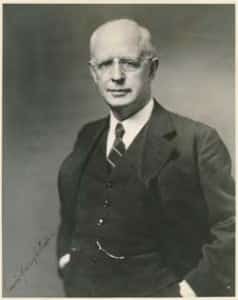 Born in 1915 in Newton Kansas, Robert Gibson Rayburn early distinguished himself in both academics and the arts. An outstanding student at Newton High School, he also excelled as a pianist, winning both state and regional awards. Closing his high school career by winning the National Oratorical Contest, he went on to graduate from Wheaton College and Omaha Presbyterian Theological Seminary (ThB, 1939, ThM, 1941). His first pastorate was in Bellevue, Nebraska (1938-42) and he next served the First Presbyterian Church of Gainesville, Texas (1942-44) while attending Dallas Theological Seminary, where he earned the ThD degree in 1944.
Born in 1915 in Newton Kansas, Robert Gibson Rayburn early distinguished himself in both academics and the arts. An outstanding student at Newton High School, he also excelled as a pianist, winning both state and regional awards. Closing his high school career by winning the National Oratorical Contest, he went on to graduate from Wheaton College and Omaha Presbyterian Theological Seminary (ThB, 1939, ThM, 1941). His first pastorate was in Bellevue, Nebraska (1938-42) and he next served the First Presbyterian Church of Gainesville, Texas (1942-44) while attending Dallas Theological Seminary, where he earned the ThD degree in 1944.
Rev. Rayburn’s first term as an Army chaplain came in 1944, serving in Europe from 1944-1946. Thereafter he returned to pastor the church in Gainesville, but was soon called to pastor the College Church of Wheaton, IL (1947-1950). With the start of the Korean War, Rev. Rayburn was called back to the chaplaincy, serving with the 187th Airborne Regimental Combat Team. Making his first parachute jump behind enemy lines in North Korea was but the first of a series of thrilling episodes recorded in the book you now hold.
By the time of his retirement from the military chaplaincy, he attained the rank of Colonel. Following the Korean War, Dr. Rayburn emerged as a leader in the Bible Presbyterian Church, being appointed to serve as president of Highland College in Pasadena, CA, and subsequently as the first president of both Covenant College and Covenant Theological Seminary (St. Louis, MO). When Covenant College relocated to Lookout Mountain, TN in 1964, Dr. Rayburn incredibly managed to teach at both institutions during that next year, dividing his time each week between the two schools.
From 1965 to 1977 he served as president of Covenant Theological Seminary. In 1976 he was diagnosed with cancer, and while stepping down from the presidency of the school in 1977, and despite operations and treatment, he continued to maintain an active schedule, working as a full professor at the school, as well as maintaining an extensive itinerary of travel and speaking engagements. Occasions of teaching at the Presbyterian Theological Seminary in Dehra Dun, India were especially rewarding for him during this time.
From 1980 to 1982, Dr. Rayburn was one of the more active proponents of the union of two conservative Presbyterian denominations. His successful efforts led to the 1982 merger of his own denomination, the Reformed Presbyterian Church, Evangelical Synod (RPCES), with the Presbyterian Church in America (PCA). His final years were spent doing what he loved best, teaching homiletics to the students at the Seminary, all the while continuing to write, speak and teach as God gave him strength. Ever a soldier in the service of his Lord, Dr. Rayburn worked right up until his death on January 5, 1990, at the age of 74.


